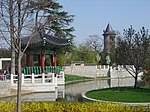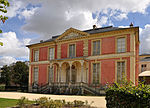Exploradôme
Museums established in 1998Museums in Val-de-MarneScience museums in France
The Exploradôme is a science museum located in Vitry-sur-Seine in the Val-de-Marne, France. It was founded by Goéry Delacôte. It is open daily; an admission fee is charged. The museum opened in 1998. Its permanent exhibition contains interactive objects designed and produced by the Exploratorium in San Francisco, including optical illusions, turbulent motion, structures and forms, and movement. The museum also contains temporary exhibits, and provides workshops for children and teenagers.
Excerpt from the Wikipedia article Exploradôme (License: CC BY-SA 3.0, Authors).Exploradôme
Route de la Porte Dauphine à la Porte des Sablons, Paris 16th Arrondissement (Paris)
Geographical coordinates (GPS) Address Phone number Website Nearby Places Show on map
Geographical coordinates (GPS)
| Latitude | Longitude |
|---|---|
| N 48.879166666667 ° | E 2.2602777777778 ° |
Address
Jardin d'Acclimatation
Route de la Porte Dauphine à la Porte des Sablons
75116 Paris, 16th Arrondissement (Paris)
Ile-de-France, France
Open on Google Maps







